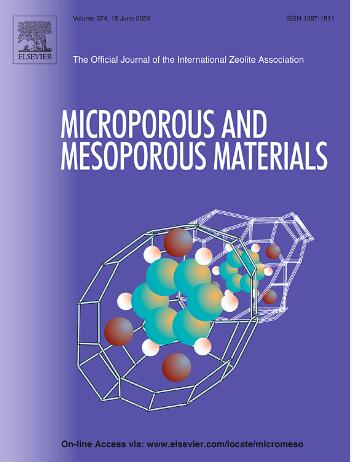Catalytic performance of Au-Ti active site on MWW zeolite for oxidative cyclohexane to cyclohexanol/one in oxysteam condition
IF 4.8
3区 材料科学
Q1 CHEMISTRY, APPLIED
引用次数: 0
Abstract
A mixture of cyclohexanol and cyclohexanone (KA oil) is the main raw material for caprolactam and adipic acid. The Ti and Au was sequentially introduced into the deboronated MWW zeolite by atom-planting (AP) method and deposition-.precipitation method as the catalyst for cyclohexane oxidation by molecular oxygen with higher selectivity of KA oil. The tetra-coordinated Ti species introduced by AP method in the zeolite framework can highly disperse the Au nano-particles as an active site for the cyclohexane oxidation. The flexible MWW zeolite layer structure facilities modification the pore structure of ERB-1 zeolite by introduction of mesopore and exposed the more silanol group on the external surface of the zeolite the exposed pore size structure can improve the cyclohexane conversion and cyclohexanol selectivity. The optimal Au nano-particle size for oxidation is around 2 nm. Moreover, the cyclohexane oxidation conditions can be optimised by varying the oxygen pressure, solvent polarity and reaction time and temperature teaccording to the radical reaction mechanism.

求助全文
约1分钟内获得全文
求助全文
来源期刊

Microporous and Mesoporous Materials
化学-材料科学:综合
CiteScore
10.70
自引率
5.80%
发文量
649
审稿时长
26 days
期刊介绍:
Microporous and Mesoporous Materials covers novel and significant aspects of porous solids classified as either microporous (pore size up to 2 nm) or mesoporous (pore size 2 to 50 nm). The porosity should have a specific impact on the material properties or application. Typical examples are zeolites and zeolite-like materials, pillared materials, clathrasils and clathrates, carbon molecular sieves, ordered mesoporous materials, organic/inorganic porous hybrid materials, or porous metal oxides. Both natural and synthetic porous materials are within the scope of the journal.
Topics which are particularly of interest include:
All aspects of natural microporous and mesoporous solids
The synthesis of crystalline or amorphous porous materials
The physico-chemical characterization of microporous and mesoporous solids, especially spectroscopic and microscopic
The modification of microporous and mesoporous solids, for example by ion exchange or solid-state reactions
All topics related to diffusion of mobile species in the pores of microporous and mesoporous materials
Adsorption (and other separation techniques) using microporous or mesoporous adsorbents
Catalysis by microporous and mesoporous materials
Host/guest interactions
Theoretical chemistry and modelling of host/guest interactions
All topics related to the application of microporous and mesoporous materials in industrial catalysis, separation technology, environmental protection, electrochemistry, membranes, sensors, optical devices, etc.
 求助内容:
求助内容: 应助结果提醒方式:
应助结果提醒方式:


